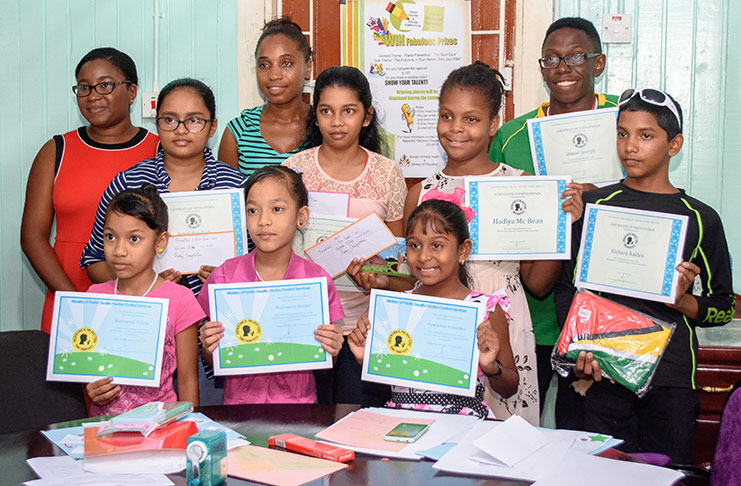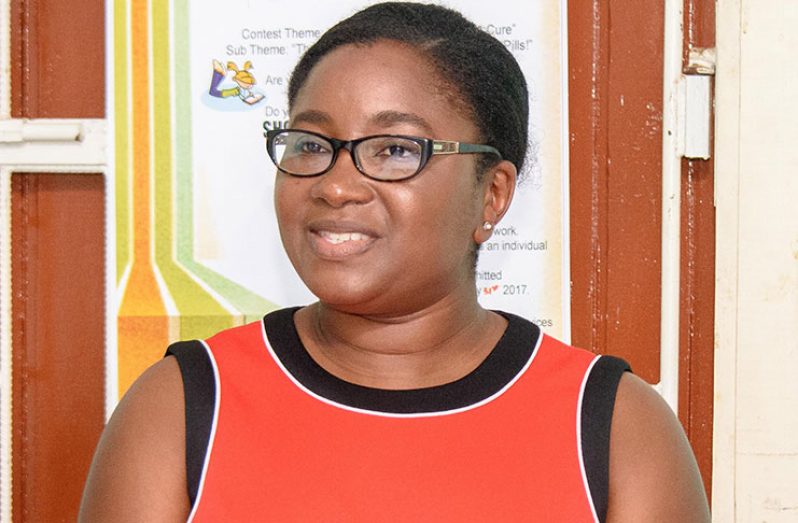…appoints school ambassadors
THE Vector Control Services Unit (VCSU) has intensified its countrywide campaign aimed at eliminating Lymphatic Filariasis commonly known as ‘big foot’ with focused attention on school-aged children.
On Monday, one week before the start of the new academic year, the VCSU appointed eight School Filaria Ambassadors. It is expected that when they return to their respective schools, the Filaria Ambassadors will disseminate critical information about the disease and the importance of receiving early treatment.
According to the World Health Organisation (WHO), Lymphatic Filariasis, which is also known as elephantiasis, is a painful and profoundly disfiguring disease. Transmitted via the culex mosquito from human to human, Filaria is caused by three species of thread-like nematode worms, known as filariae – Wuchereria bancrofti, Brugia malayi and Brugia timori.

Though the disease affects all ages, the disease takes a number of years to develop and may cause temporary or permanent disability. Here in Guyana, several campaigns have been initiated to bring an end to the disease, since the country has signed onto WHO Resolution to eliminate the disease.
The Coordinator of the Neglected Infectious Disease Programme and the National Coordinator for the Elimination of Lymphatic Filariasis Campaign, Dr. Fabu Moses, explained that in 1997 WHO classified Lymphatic Filariasis, along with five other infectious diseases, as eradicable or potentially eradicable. It was also in 1997 that the World Health Assembly adopted Resolution WHA 50.29 which called on member states to initiate steps to eliminate Lymphatic Filariasis as a public health problem. In response, WHO launched the Global Programme to Eliminate Lymphatic Filariasis (GPELF) in 2000.
Dr. Moses noted that Guyana signed onto the resolution in 2000 and immediately sprang into action. “By 2001, we had mapped the entire country, and this is how we know that more than 90 per cent of the Guyanese population is at risk of developing Lymphatic Filariasis because of the mapping that we did,” she said.
The national coordinator explained that following that mapping exercise, the country initiated the diethylcarbamazine (DEC) salt campaign through Mass Drug Administration (MDA) in keeping with GPELF.
But the DEC Salt Campaign had proven to be a difficult one, Dr. Moses said, explaining that the Public Health Ministry was unable to determine the number of persons using DEC Salt as against the regular salt.
Guyana, she pointed out, is among four countries in the Americas that are yet to eliminate Filaria.
“The other three countries are Haiti, Brazil and The Dominican Republic. However, Brazil is nearing elimination, Haiti has gone a far way in the sense that their entire population has been covered under a mass drug administration, and The Dominican Republic is also nearing elimination, so it kind of leaves Guyana to catch up with those countries in this part of the world,” she pointed out.
Countries such as Suriname and Trinidad have already eliminated the decease.
Cognisant of the fact that Guyana has been lagging with respect to its progress of elimination, Dr. Moses said alternative programmes have been initiated with the Vector Control Services Unit moving into public spaces and places such as the schools, hospitals, health centres, workplaces and market places.
At these locations, the unit administers the filarial pills – DEC and albendazole – as a protective measure to all persons at risk of being bitten by a culex mosquito. These pills, Dr. Moses stressed, must be taken every year for five consecutive years for them to be effective.
“Filaria is actually a disease that is caused by a worm Wuchereria bancrofti and Wuchereria bancrofti is passed from one human to the next by the bite of an infected culex mosquito. So once the culex mosquito has this tiny worm inside, it can pass from one person to the next,” she posited, while underscoring the importance of disrupting the transmission by using the correct dosage within the specified period.
It was noted that if the programmes fails to achieve its 65 per cent coverage in any given year, it would have to be reinitiated to ensure its effectiveness. Hence, the programme lasts longer in some communities than others.
“That is because there may have been one year or more than one year where we did not reach the target, and once we do not reach the target, we have to continue until we have five consecutive years of reaching that target, because the worm that causes this lives for five to eight years,” she explained.
The national coordinator did not disclose the number of persons diagnosed with the disease.
“So the amount of people that we have in our clinic in no way is a representation of the amount of people who actually have the disease. We say this because Filaria is a hidden disease. It is very much stigmatised and so a lot of people do not come to clinic.”
In addition to administering the tablets, Dr. Moses said the unit has been raising awareness among all groups of people. This time around, the attention was placed on school-aged children.
To encourage their participation in the campaign, Dr. Allena Hercules said children ages six to 18 were encouraged to compete in three categories, Essay Writing, Poetry and Poster. On Monday, a one-day workshop was held at the unit for the winners, who are now considered ambassadors for the programme.
In the Essay Competition for the six to nine category, Roshenna Holder emerged the winner, while Arysh Raghunauth came in second. In the 10-13 category for the essay competition, there was no first-place winner based on the points system, but Hadiya McBean was adjudged the second-place winner, while Amanda Omaran came in third.
For the 14-18 category, Sundarsham Singh copped the top spot, while Omari Joseph and Junior Kandasammy came in second. David Jackson received third place.
Meanwhile, in the Poster Competition, there were no first and second-place winners, but the Lusignan Good Hope Learning Centre, which made a group submission, came in third. There were no winners in the 10-13 category, while Amia Bristol secured third place in the 14-18 category for the Poster Competition.
For the poetry competition, there were no winners in the 6-9 category. In the 10-13 category, Aruni Prashad and Daniel Seenjan, who made a group submission, received second place. Similarly, in the 14-18 category, there was no first-place winner, but based on the points system, Omari Joseph was presented with the second-place prize.












